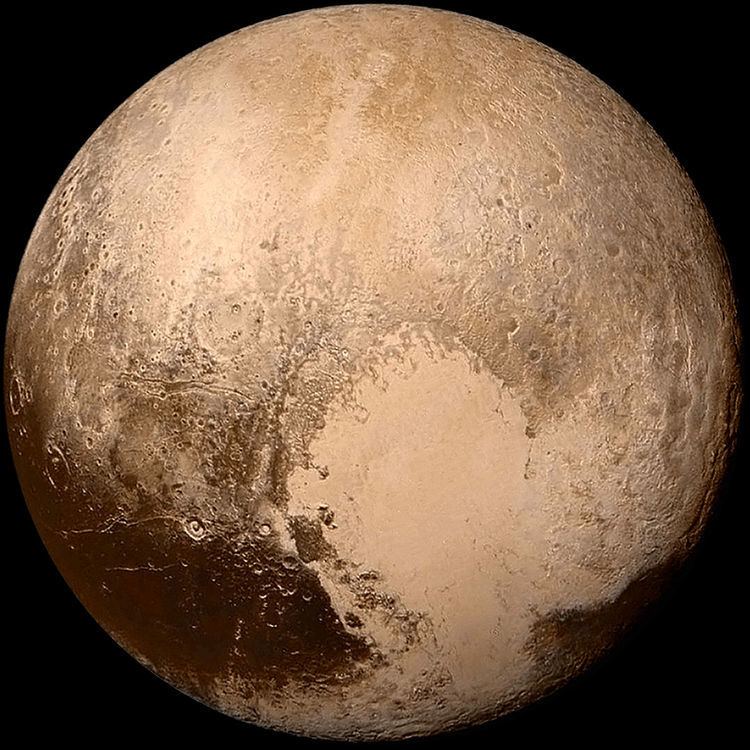 | ||
Geography of pluto tombaugh region and elliot crater
The geography of Pluto entails the delineation and characterization of regions on Pluto. Plutonian geography is mainly focused on what is called physical geography on Earth; that is, the distribution of physical features across Pluto and their cartographic representations. On 14 July 2015, the New Horizons spacecraft became the first spacecraft to fly by Pluto. During its brief flyby, New Horizons made detailed geographical measurements and observations of Pluto and its moons.
Contents
- Geography of pluto tombaugh region and elliot crater
- Orientation
- Topographical features
- Cthulhu Regio
- Tombaugh Regio
- The Brass Knuckles
- The Donut
- Topography
- Nomenclature
- References
Orientation
Pluto may be defined as having retrograde rotation and an axial tilt of 60 degrees, or prograde rotation and a tilt of 120 degrees. Following the latter convention (the right-hand rule), the hemisphere currently in daylight is the northern one, with much of the southern hemisphere in darkness. This is the convention used by the International Astronomical Union (IAU) and the New Horizons team, and their maps put the sunlit hemisphere on top. However, older sources may define Pluto's rotation as retrograde and therefore the sunlit side as the southern hemisphere. East and west are also swapped between the two conventions.
Topographical features
The following names are informal names and nicknames, proposed by the New Horizons discovery team. They were taken from various chthonic deities or demons, some from ancient mythology and others from modern popular culture, but have yet to be considered by the IAU.
Cthulhu Regio
Cthulhu Regio, nicknamed The Whale after its shape, is an elongated, dark region along Pluto's equator named after the fictional deity from the works of H. P. Lovecraft. It is 2,990 km (1,860 mi) long and is the largest dark feature on Pluto. The dark color of the region is speculated to be the result of a "tar" made of complex hydrocarbons called tholins covering the surface, formed from methane and nitrogen in the atmosphere interacting with ultraviolet light and cosmic rays. The presence of a large number of craters within Cthulhu indicates that it is perhaps billions of years old, in contrast to the adjacent bright, craterless Sputnik Planitia, which may be as little as 100 million years old.
Tombaugh Regio
Tombaugh Regio, nicknamed The Heart, is a large, light-colored region in the shape of a heart named after the discoverer of Pluto, Clyde Tombaugh. Two lobes of the heart are distinct geological features sharing a bright appearance, with the western lobe (Sputnik Planitia, a vast plain of nitrogen and other ices) smoother than the eastern lobe. The heart is about 1,590 km (990 mi) across. The region contains 3,400 m (11,000 ft) mountains made of water ice, Hillary Montes and Norgay Montes, along its southwestern edge. The lack of craters suggests that its surface there is less than 100 million years old and hence that Pluto is probably geologically active. Subsequent data indicated that features near the edges of the region show evidence of ice flow such as glaciers, and light material overlying the darker material at the eastern edge of Cthulhu Regio.
The Brass Knuckles
A series of semi-regularly spaced dark spots with irregular boundaries are nicknamed the Brass Knuckles. They average about 480 km (300 mi) in diameter and are located along the equator between the Heart and the tail of the Whale. The brass knuckles are separated from one another by tall uplands. There are also many canyons running through them and through the surrounding mountains that are hundreds of miles long and several miles deep. From west (south of Tombaugh Regio) to east (west of the Whale's tail), the Knuckles are:
The Donut
A bright, ring-shaped feature about 350 km (220 mi) across located near the tail of the "Whale" in low-resolution images is nicknamed the "Donut". It does not appear as a ring in higher-resolution images.
Topography
The prime meridian of Pluto is defined as the longitude facing Charon.
Nomenclature
The Working Group for Planetary System Nomenclature of the International Astronomical Union is responsible for assigning official names to surface features on Pluto. By August 2015 no name had been approved.
As of August 2015, the New Horizons science team derives informal names from the following themes: explorers, space missions, spacecraft, scientists and engineers; fictional explorers, travellers, vessels, destinations and origins; authors and artists who have envisioned exploration; and fictional underworlds, underworld beings, and travellers to the underworld. The New Horizons science team has invited members of the public to propose names and vote on them before the spacecraft's arrival.
